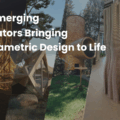Do you want to be a product engineer? Or, maybe your dream is to take place among the great architects and designers using your vision to create things that inspire people across the globe? That’s great, but to get there might not seem easy sometimes and it’s going to take a lot of blood sweat, and mastery of the tools needed to bring your concept to life.
Computer-aided design (CAD) has a huge impact on product design which has replaced manual drafting. Thanks to CAD, designers, architects, and engineers are able to make more accurate representations and improve the design quality. Nowadays, the use of computers helps not only to create technical illustrations in 2D or 3D but also enables the modification and optimization of the design process without a pencil and paper.

Current CAD software development focuses on automating various aspects of design and production and the development of new algorithms
In the 1970s the first CAD programs were designed to create 2D models only, and during the 1980s 3D design trends became integrated into new CAD programs. And in the 1990s the future of CAD has been changed and its training has continued to grow. Current CAD software development focuses on automating various aspects of design and production and the development of new algorithms. And even some CAD programs are industry-specific or have add-ons to customize your CAD experience. CAD software has become a step up throughout the construction industry and through all of its processes. It has changed construction into a technology job. We can see the beginning of something new and fresh in 2D design trends as well as in 3D design trends. The growing use of CAD software shows the way to new evolutions.

Thanks to Artificial Intelligence, CAD programs will progressively become more intelligent allowing users to automate design tasks
The CAD has undergone major changes since its inception and it is one of the final markets to embrace cloud-based solutions over on-premise solutions. It is planned to operate in the cloud and is intended to increase collaboration between designers and product managers. So, of course, many companies are adopted cloud-based CAD at higher rates. Cloud design platforms give a huge opportunity to use it on multiple devices and anywhere in the world. CAD users need better collaboration with their team. So that’s why the cloud is becoming so essential.
Thanks to Artificial Intelligence, CAD programs will progressively become more intelligent allowing users to automate design tasks.
While CAD software started out much simpler, as basic 2D design software, it is now super complex, and the latest trends are pushing it even further. Software makers are continuously improving features, and as new 2d and 3d trends are appearing, we can see the shape of the future of CAD software.
And what are the next trends in CAD software? One of the greatest trends these years is automation. Which will indeed improve your work and allow you to avoid 3D modeling problems. Thanks to Artificial Intelligence, CAD programs will progressively become more intelligent allowing users to automate design tasks.
BeeGraphy is the first web platform in the world to present precision-ready models for production. The platform gives you an opportunity to change the parameters of the 3d models and download the file with the modified parameters. Beegraphy allows 3D designers to work as a team on its platform, while at the same time allowing the customer, the manufacturer to follow the work online. Working with NURBS ( Non-Uniform Rational B-Splines) software language is a way for CAD innovation, as it provides theoretically endless possibilities and maximum accuracy in calculations.
BeeGraphy enables you to actualize your long-held dream, without having a professional education, you can carry out wonderful design ideas in the online world. This is the platform where we bring together designers, manufacturers, engineers, architects and creators, emphasizing the fact that everyone in the world can create masterpieces in minutes without special professional skills.
















